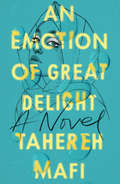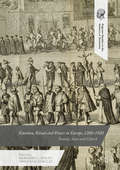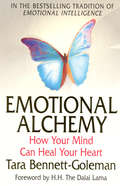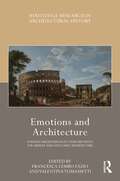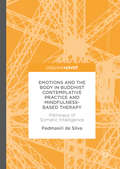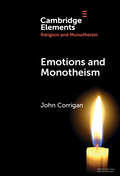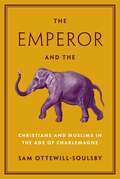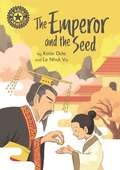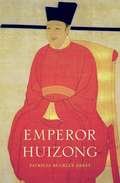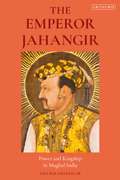- Table View
- List View
An Emotion Of Great Delight
by Tahereh MafiFrom bestselling author of the Shatter Me series and the National Book Award-nominated A Very Large Expanse of Sea, Tahereh Mafi, comes a stunning novel about love and loneliness, navigating dual-identity as a Muslim teenager in America, and reclaiming your right to joy.
Emotion, Ritual and Power in Europe, 1200-1920: Family, State and Church (Palgrave Studies in the History of Emotions)
by Katie Barclay Merridee L. BaileyThis volume spans the fourteenth to nineteenth centuries, across Europe and its empires, and brings together historians, art historians, literary scholars and anthropologists to rethink medieval and early modern ritual. The study of rituals, when it is alert to the emotions which are woven into and through ritual activities, presents an opportunity to explore profoundly important questions about people’s relationships with others, their relationships with the divine, with power dynamics and importantly, with their concept of their own identity. Each chapter in this volume showcases the different approaches, theories and methodologies that can be used to explore emotions in historical rituals, but they all share the goal of answering the question of how emotions act within ritual to inform balances of power in its many and varied forms. Chapter 5 of this book is available open access under a CC BY 4.0 license.
Emotion, Ritual and Power in Europe, 1200–1920: Family, State and Church (Palgrave Studies in the History of Emotions)
by Merridee L. Bailey Katie BarclayThis volume spans the fourteenth to nineteenth centuries, across Europe and its empires, and brings together historians, art historians, literary scholars and anthropologists to rethink medieval and early modern ritual. The study of rituals, when it is alert to the emotions which are woven into and through ritual activities, presents an opportunity to explore profoundly important questions about people’s relationships with others, their relationships with the divine, with power dynamics and importantly, with their concept of their own identity. Each chapter in this volume showcases the different approaches, theories and methodologies that can be used to explore emotions in historical rituals, but they all share the goal of answering the question of how emotions act within ritual to inform balances of power in its many and varied forms. Chapter 5 of this book is available open access under a CC BY 4.0 license.
Emotion, Truth and Meaning: In Defense of Ayer and Stevenson (Library of Ethics and Applied Philosophy #12)
by C. WilksThe Emotive Theory was theory ahead of its time, and a theory which was, perhaps understandably, misinterpreted, misrepresented, and ridiculed by its critics from the outset. In this work, the author acquaints the reader with what the original emotivists actually claimed, and enriches their claims by psychologically expanding them. He thus develops an enriched emotive theory.
Emotional Alchemy: How The Mind Can Heal The Heart
by Tara Bennett-GolemanAlchemists sought to transform lead into gold. This book shows how we similarly all have the natural ability to turn the lead of our confused minds into the gold of insightful clarity. Tara Bennett shows how we can learn to see ourselves as we really are and thus learn to disengage from those emotional patterns that undermine our lives. Drawing on the latest research into cognitive science and neuroscience with ancient principles of Buddhist psychology, this profound yet very practical book shows how practicing mindfulness can heal the very heart of our being.'A wise and practical guide to emotional freedom' Joseph Goldstein, author of Insight Meditation'A wonderfully clear, compassionate and insightful guide to freeing ourselves from difficult emotions' Sharon Salzberg, author of LovingKindness'Written with humour [and] warmheartedness in lively prose -' Naomi Wolf, author of The Beauty Myth
Emotional and Priestly Logic of Plural Marriage, The (Arrington Lecture Series #15)
by Kathleen FlakeKathleen Flake, associate professor of American religious history at Vanderbilt University examines the logic of those women who thrived, rather than suffered, in early Mormon polygamy, and finds that the marriage covenant granted them priestly rights and independence through the powers of heaven.
Emotional monasticism: Affective piety in the eleventh-century monastery of John of Fécamp (Artes Liberales)
by Lauren ManciaMedievalists have long taught that highly emotional Christian devotion, often called ‘affective piety’, appeared in Europe after the twelfth century and was primarily practiced by communities of mendicants, lay people and women. Emotional monasticism challenges this view. The first study of affective piety in an eleventh-century monastic context, it traces the early history of affective devotion through the life and works of the earliest known writer of emotional prayers, John of Fécamp, abbot of the Norman monastery of Fécamp from 1028–78. Exposing the early medieval monastic roots of later medieval affective piety, the book casts a new light on the devotional life of monks in Europe before the twelfth century and redefines how medievalists should teach the history of Christianity.
Emotional monasticism: Affective piety in the eleventh-century monastery of John of Fécamp (Artes Liberales)
by Lauren ManciaMedievalists have long taught that highly emotional Christian devotion, often called ‘affective piety’, appeared in Europe after the twelfth century and was primarily practiced by communities of mendicants, lay people and women. Emotional monasticism challenges this view. The first study of affective piety in an eleventh-century monastic context, it traces the early history of affective devotion through the life and works of the earliest known writer of emotional prayers, John of Fécamp, abbot of the Norman monastery of Fécamp from 1028–78. Exposing the early medieval monastic roots of later medieval affective piety, the book casts a new light on the devotional life of monks in Europe before the twelfth century and redefines how medievalists should teach the history of Christianity.
Emotions and Architecture: Forging Mediterranean Cities Between the Middle Ages and Early Modern Time (Routledge Research in Architectural History)
by Francesca Lembo Fazio Valentina TomassettiEmotions and Architecture: Forging Mediterranean Cities Between the Middle Ages and Early Modern Time explores architecture as a medium to arouse or conceal emotions, to build consensus through shared values, or to reconnect the urban community to its alleged ancestry. The chapters in this edited collection outline how architectonic symbols, images, and structures were codified – and sometimes recast – to match or to arouse emotions awakened by wars, political dominance, pandemic challenges, and religion. As signs of spiritual and political power, these elements were embraced and modulated locally, providing an endorsement to authorities and rituals for the community. This volume provides an overview of the phenomenon across the Italian region, stressing the transnationality of selected symbols and their various declinations in local contexts. It deepens the issue of refitting symbols, artworks, and structures to arouse emotions by carefully analysing specific cases, such as the Septizodium in Rome, the Holy House of Loreto in Venice, and the reconstruction of L'Aquila. The collection, through its variegated contributions, offers a comprehensive view of the phenomenon: exploring the issue from political, social, religious, and public health perspectives, and seeking to propose a new definition of architecture as a visual emotional language. Together, the chapters show how the representation of virtues and emotions through architecture was part of a symbolic practice shared by many across the Italian context. This book will be of interest to researchers and students studying architectural history, the history of emotions, and the history of art.
Emotions and Architecture: Forging Mediterranean Cities Between the Middle Ages and Early Modern Time (Routledge Research in Architectural History)
Emotions and Architecture: Forging Mediterranean Cities Between the Middle Ages and Early Modern Time explores architecture as a medium to arouse or conceal emotions, to build consensus through shared values, or to reconnect the urban community to its alleged ancestry. The chapters in this edited collection outline how architectonic symbols, images, and structures were codified – and sometimes recast – to match or to arouse emotions awakened by wars, political dominance, pandemic challenges, and religion. As signs of spiritual and political power, these elements were embraced and modulated locally, providing an endorsement to authorities and rituals for the community. This volume provides an overview of the phenomenon across the Italian region, stressing the transnationality of selected symbols and their various declinations in local contexts. It deepens the issue of refitting symbols, artworks, and structures to arouse emotions by carefully analysing specific cases, such as the Septizodium in Rome, the Holy House of Loreto in Venice, and the reconstruction of L'Aquila. The collection, through its variegated contributions, offers a comprehensive view of the phenomenon: exploring the issue from political, social, religious, and public health perspectives, and seeking to propose a new definition of architecture as a visual emotional language. Together, the chapters show how the representation of virtues and emotions through architecture was part of a symbolic practice shared by many across the Italian context. This book will be of interest to researchers and students studying architectural history, the history of emotions, and the history of art.
Emotions and The Body in Buddhist Contemplative Practice and Mindfulness-Based Therapy: Pathways of Somatic Intelligence
by Padmasiri De SilvaThis book represents an outstanding contribution to the field of somatic psychology. It focuses on the relationship between body and emotions, and on the linkages between mindfulness-based emotion studies and neuroscience. The author discusses the awakening of somatic intelligence as a journey through pain and trauma management, the moral dimensions of somatic passions, and the art and practice of embodied mindfulness. Issues such as the emotions and the body in relation to Buddhist contemplative practice, against the background of the most recent findings of current neuroscience, are expanded in the book. A broad review of the Darwinian-Jamesian heritage on emotion studies is a unique contribution to the tradition of the somatogenic strands of emotions, and provides a contrasting focus to the ideogenic emotions in Sigmund Freud. This work provides an invaluable resource for students of psychology and philosophy, psychotherapists and meditation teachers, students, and for anyone with an interest in the field of somatic psychology.
Emotions and The Body in Buddhist Contemplative Practice and Mindfulness-Based Therapy: Pathways of Somatic Intelligence
by Padmasiri De SilvaThis book represents an outstanding contribution to the field of somatic psychology. It focuses on the relationship between body and emotions, and on the linkages between mindfulness-based emotion studies and neuroscience. The author discusses the awakening of somatic intelligence as a journey through pain and trauma management, the moral dimensions of somatic passions, and the art and practice of embodied mindfulness. Issues such as the emotions and the body in relation to Buddhist contemplative practice, against the background of the most recent findings of current neuroscience, are expanded in the book. A broad review of the Darwinian-Jamesian heritage on emotion studies is a unique contribution to the tradition of the somatogenic strands of emotions, and provides a contrasting focus to the ideogenic emotions in Sigmund Freud. This work provides an invaluable resource for students of psychology and philosophy, psychotherapists and meditation teachers, students, and for anyone with an interest in the field of somatic psychology.
Emotions and Monotheism (Elements in Religion and Monotheism)
by null John CorriganThe emotional turn in scholarship has changed the way in which historians of religion think about monotheistic traditions. New histories of religion have adapted and incorporated the totalizing sensibilities of twentieth century annalistes, the granular view of social historians, groundbreaking philosophical investigations, and the spirit of interdisciplinary collaboration between historical analysis, anthropology, and psychology. Religion as a principal bearer of culture has shaped emotional life profoundly, just as human emotion has constituted religious life. Taking a qualified constructivist approach to emotion enables understanding of the dynamism, fluidity, and ambiguity in emotional experience, alongside continuities, and facilitates analysis of how that feeling has animated religious life in monotheistic traditions. It equally sharpens insight into how monotheistic religion itself has made emotion. Affect, emotion, and mixed emotions are three categories of feelings evidenced in monotheistic religions. Each is illustrated with respect to the similarities and differences among Judaism, Christianity, and Islam.
Emotions and Religious Dynamics
by Nathaniel A. WarneWe all feel emotions and are moved to action by them. Religious communities often select and foster certain emotions over others. Without understanding this it is hard to grasp the way groups view the world and each other. Often, it is the underlying emotional pattern of a group rather than its doctrines that either divides it from, or attracts it to, others. These issues, so important in today's world, are explored in this book in a genuinely interdisciplinary way by anthropologists, psychologists, theologians and historians of religion, and in some detailed studies of well and less well known religious traditions from across the world.
Emotions and Religious Dynamics
by Nathaniel A. WarneWe all feel emotions and are moved to action by them. Religious communities often select and foster certain emotions over others. Without understanding this it is hard to grasp the way groups view the world and each other. Often, it is the underlying emotional pattern of a group rather than its doctrines that either divides it from, or attracts it to, others. These issues, so important in today's world, are explored in this book in a genuinely interdisciplinary way by anthropologists, psychologists, theologians and historians of religion, and in some detailed studies of well and less well known religious traditions from across the world.
Emotions in Korean Philosophy and Religion: Confucian, Comparative, and Contemporary Perspectives (Palgrave Studies in Comparative East-West Philosophy)
by Edward Y. J. Chung Jea Sophia OhThis pioneering book presents thirteen articles on the fascinating topic of emotions (jeong 情) in Korean philosophy and religion. Its introductory chapter comprehensively provides a textual, philosophical, ethical, and religious background on this topic in terms of emotions West and East, emotions in the Chinese and Buddhist traditions, and Korean perspectives. Chapters 2 to 5 of part I discuss key Korean Confucian thinkers, debates, and ideas. Chapters 6 to 8 of part II offer comparative thoughts from Confucian moral, political, and social angles. Chapters 9 to 12 of part III deal with contemporary Buddhist and eco-feminist perspectives. The concluding chapter discusses ground-breaking insights into the diversity, dynamics, and distinctiveness of Korean emotions.This is an open access book.
Emotions in Muslim Hausa Women's Fiction: More than Just Romance (Global Africa)
by Umma Aliyu MusaThis book examines the emotions expressed in Hausa women’s prose fiction in northern Nigeria, showing how Hausa Muslim women writers use fiction in their indigenous language to demonstrate and express their anger about the problems they face in a patriarchal society. Umma Aliyu Musa shows how Hausa women authors use literature as a subversive instrument to voice their anger and draw attention to their plight, and what they perceive to be unfair traditional authority in a male-dominated society. Their stories about women protagonists who rebel against existing traditional structures enable women readers to understand the anger experienced by other women who have gone through similar situations. Issues at the heart of these women's narratives include forced marriage, polygyny, family honor and the effects of love. The authors' use of metaphorical expressions of anger, particularly those registered through body parts, provides insight into Hausa women's thoughts, culture and socialization within their private spheres. Thus, writing by these women in the Hausa language creates an effective communication network that offers insight into domestic ecology as it affects women. Emotions in Muslim Hausa Women's Fiction will be of interest to scholars and students of African literature, postcolonial literature, gender studies in African society, womanism, emotions and indigenous African fiction studies.
Emotions in Muslim Hausa Women's Fiction: More than Just Romance (Global Africa)
by Umma Aliyu MusaThis book examines the emotions expressed in Hausa women’s prose fiction in northern Nigeria, showing how Hausa Muslim women writers use fiction in their indigenous language to demonstrate and express their anger about the problems they face in a patriarchal society. Umma Aliyu Musa shows how Hausa women authors use literature as a subversive instrument to voice their anger and draw attention to their plight, and what they perceive to be unfair traditional authority in a male-dominated society. Their stories about women protagonists who rebel against existing traditional structures enable women readers to understand the anger experienced by other women who have gone through similar situations. Issues at the heart of these women's narratives include forced marriage, polygyny, family honor and the effects of love. The authors' use of metaphorical expressions of anger, particularly those registered through body parts, provides insight into Hausa women's thoughts, culture and socialization within their private spheres. Thus, writing by these women in the Hausa language creates an effective communication network that offers insight into domestic ecology as it affects women. Emotions in Muslim Hausa Women's Fiction will be of interest to scholars and students of African literature, postcolonial literature, gender studies in African society, womanism, emotions and indigenous African fiction studies.
Emotions, Moral Formation, and Christian Politics: Rereading Karl Barth (T&T Clark Enquiries in Theological Ethics)
by Dr Jonathan M. CahillThis volume addresses the social-relational nature of moral formation, emotions, and moral agency. Drawing on Barth's theological anthropology and his relational conception of the self, Cahill argues that Barth envisions moral progress as rooted in the growth of the community. Cahill also explores Barth's view of emotion in conversation with the study of emotions in psychology, sociology, neuroscience, and philosophy. Building on Barth and these other disciplines Cahill argues for a relational and cognitive conception of emotions while highlighting emotions' critical role in regulating group and social relations. Emotions are fundamental to interpersonal interactions, to group relations, and for the reinforcement and disruption of social structures. This account of moral formation and emotion is illustrated through the example of climate change. A community shaped by love for God, solidarity with other creatures, and a concern for all of creation leads to an awareness of hegemonic forces and fosters emotions shaped by the kingdom of God that enables the struggle for climate justice.
Emotions, Moral Formation, and Christian Politics: Rereading Karl Barth (T&T Clark Enquiries in Theological Ethics)
by Dr Jonathan M. CahillThis volume addresses the social-relational nature of moral formation, emotions, and moral agency. Drawing on Barth's theological anthropology and his relational conception of the self, Cahill argues that Barth envisions moral progress as rooted in the growth of the community. Cahill also explores Barth's view of emotion in conversation with the study of emotions in psychology, sociology, neuroscience, and philosophy. Building on Barth and these other disciplines Cahill argues for a relational and cognitive conception of emotions while highlighting emotions' critical role in regulating group and social relations. Emotions are fundamental to interpersonal interactions, to group relations, and for the reinforcement and disruption of social structures. This account of moral formation and emotion is illustrated through the example of climate change. A community shaped by love for God, solidarity with other creatures, and a concern for all of creation leads to an awareness of hegemonic forces and fosters emotions shaped by the kingdom of God that enables the struggle for climate justice.
The Emperor and the Elephant: Christians and Muslims in the Age of Charlemagne
by Sam Ottewill-SoulsbyA new history of Christian-Muslim relations in the Carolingian period that provides a fresh account of events by drawing on Arabic as well as western sourcesIn the year 802, an elephant arrived at the court of the Emperor Charlemagne in Aachen, sent as a gift by the ʿAbbasid Caliph, Harun al-Rashid. This extraordinary moment was part of a much wider set of diplomatic relations between the Carolingian dynasty and the Islamic world, including not only the Caliphate in the east but also Umayyad al-Andalus, North Africa, the Muslim lords of Italy and a varied cast of warlords, pirates and renegades. The Emperor and the Elephant offers a new account of these relations. By drawing on Arabic sources that help explain how and why Muslim rulers engaged with Charlemagne and his family, Sam Ottewill-Soulsby provides a fresh perspective on a subject that has until now been dominated by and seen through western sources.The Emperor and the Elephant demonstrates the fundamental importance of these diplomatic relations to everyone involved. Charlemagne and Harun al-Rashid’s imperial ambitions at home were shaped by their dealings abroad. Populated by canny border lords who lived in multiple worlds, the long and shifting frontier between al-Andalus and the Franks presented both powers with opportunities and dangers, which their diplomats sought to manage.Tracking the movement of envoys and messengers across the Pyrenees, the Mediterranean and beyond, and the complex ideas that lay behind them, this book examines the ways in which Christians and Muslims could make common cause in an age of faith.
The Emperor and the Seed: Independent Reading 12 (Reading Champion #511)
by Katie DaleThis story is part of Reading Champion, a series carefully linked to book bands to encourage independent reading skills, developed with Dr Sue Bodman and Glen Franklin of UCL Institute of Education (IOE). This book is aimed at Independent Reading 12, for readers aged 7 years old and up, or in the second half of Year 3.The emperor needs someone to take over his throne. When he challenges the children of his kingdom to grow the best plant they can from a seed he gives them, young Ling is dismayed - he can't get it to grow no matter what he does! When he brings his empty pot to the emperor, he knows he has lost the challenge. Or has he?Reading Champion offers independent reading books for children to practise and reinforce their developing reading skills.Fantastic, original stories are accompanied by engaging artwork and a reading activity. Each book has been carefully graded so that it can be matched to a child's reading ability, encouraging reading for pleasure.The Key Stage 2 Reading Champion Books are suggested for use as follows:Independent Reading 11: start of Year 3 or age 7+Independent Reading 12: end of Year 3 or age 7+Independent Reading 13: start of Year 4 or age 8+Independent Reading 14: end of Year 4 or age 8+Independent Reading 15: start of Year 5 or age 9+Independent Reading 16: end of Year 5 or age 9+Independent Reading 17: start of Year 6 or age 10+Independent Reading 18: end of Year 6 or age 10+
Emperor Huizong: The Collections Of Emperor Huizong (A\china Program Book Ser. #266)
by Patricia Buckley EbreyChina was the most advanced country in the world when Huizong ascended the throne in 1100 CE. Artistically gifted, he guided the Song Dynasty toward cultural greatness but is known to posterity as a political failure who lost the throne to Jurchen invaders and died their prisoner. In this comprehensive biography, Patricia Ebrey corrects the prevailing view of Huizong as decadent and negligent, recasting him as a ruler ambitious in pursuing glory for his flourishing realm. After a rocky start trying to overcome political animosities at court, Huizong turned his attention to the good he could do. He greatly expanded the court's charitable ventures, founding schools, hospitals, orphanages, and paupers' cemeteries. Surrounding himself with poets, painters, and musicians, he built palaces, temples, and gardens of unsurpassed splendor. Often overlooked, however, is the importance of Daoism in Huizong's life. He treated spiritual masters with great deference, wrote scriptural commentaries, and urged his subjects to adopt his beliefs and practices. This devotion to the Daoist vision of sacred kingship eventually alienated the Confucian mainstream and compromised Huizong's ability to govern. Ebrey's lively biography adds new dimensions of understanding to a passionate, paradoxical ruler who, many centuries later, inspires both admiration and disapproval.
Emperor Huizong
by Patricia Buckley EbreyChina was the most advanced country in the world when Huizong ascended the throne in 1100 CE. Artistically gifted, he guided the Song Dynasty toward cultural greatness but is known to posterity as a political failure who lost the throne to Jurchen invaders and died their prisoner. In this comprehensive biography, Patricia Ebrey corrects the prevailing view of Huizong as decadent and negligent, recasting him as a ruler ambitious in pursuing glory for his flourishing realm. After a rocky start trying to overcome political animosities at court, Huizong turned his attention to the good he could do. He greatly expanded the court's charitable ventures, founding schools, hospitals, orphanages, and paupers' cemeteries. Surrounding himself with poets, painters, and musicians, he built palaces, temples, and gardens of unsurpassed splendor. Often overlooked, however, is the importance of Daoism in Huizong's life. He treated spiritual masters with great deference, wrote scriptural commentaries, and urged his subjects to adopt his beliefs and practices. This devotion to the Daoist vision of sacred kingship eventually alienated the Confucian mainstream and compromised Huizong's ability to govern. Ebrey's lively biography adds new dimensions of understanding to a passionate, paradoxical ruler who, many centuries later, inspires both admiration and disapproval.
The Emperor Jahangir: Power and Kingship in Mughal India
by Lisa BalabanlilarJahangir was the fourth of the six “Great Mughals,” the oldest son of Akbar the Great, who extended the Mughal Empire across the Indian Subcontinent, and the father of Shah Jahan, builder of the Taj Mahal. Although an alcoholic and opium addict, his reputation marred by rebellion against his father, once enthroned the Emperor Jahangir proved to be an adept politician. He was also a thoughtful and reflective memoirist and a generous patron of the arts, responsible for an innovative golden age in Mughal painting. Through a close study of the seventeenth century Mughal court chronicles, The Emperor Jahangir sheds new light on this remarkable historical figure, exploring Jahangir's struggle for power and defense of kingship, his addictions and insecurities, his relationship with his favourite wife, the Empress Nur Jahan, and with his sons, whose own failed rebellions bookended his reign.
